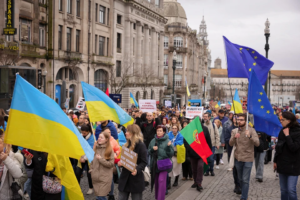
In September 2025, EU countries adopted 79,205 new decisions to grant temporary protection to non-EU citizens who fled Ukraine as a result of Russian aggression, which is 49% more than in August 2025 and is the highest monthly average of new decisions recorded since August 2023.
“This increase came after the Ukrainian government adopted a decree at the end of August 2025 granting men aged 18 to 22 inclusive the right to leave Ukraine without hindrance,” Eurostat reported on its website on Monday.
According to its data, compared to the end of August 2025, the total number of people from Ukraine under temporary protection increased by 49,560 (+1.2%) to 4,302,160 at the end of September.
In its statistics for August, the agency reported a higher total figure of 4,373,460, but this included data from Portugal and Luxembourg, where there were 65,120 and 3,880 refugees from Ukraine with the corresponding status, respectively.
It is noted that in September, according to available data, the number of people under temporary protection increased in 24 EU countries. The largest absolute increase was recorded in Poland (+12,960; +1.3%), Germany (+7,585; +0.6%) and the Czech Republic (+3,455; +0.9%), while the only decrease was in France (-240; -0.4%).
According to Eurostat data, Germany remains the country with the largest number of refugees from Ukraine in the EU and the world – 1 million 218.1 thousand, or 28.3% of the total number of beneficiaries in the EU.
The top three also include Poland with 1 million 8,890, or 23.5%, and the Czech Republic with 389,310, or 9.0%. Spain with 244,170 and Romania with 192,840 follow with a significant gap.
Eurostat clarified that the data for Spain, Greece, and Cyprus includes some people whose temporary protection status is no longer valid.
According to the agency’s data, compared to the population of each EU member state, the highest number of temporary protection beneficiaries per thousand people at the end of September 2025 was observed in the Czech Republic (35.7), Poland (27.6), and Latvia (25.5), while the corresponding figure at the EU level is 9.6.
It is also noted that as of the end of September 2025, Ukrainian citizens accounted for more than 98.4% of temporary protection beneficiaries. Adult women accounted for 44% of temporary protection recipients in the EU, children for almost a third (31.0%), while adult men accounted for about a quarter (25.1%) of the total. A year earlier, women accounted for 45%, children for 32.3%, and adult men for 22.7%, while at the end of September 2023, adult women accounted for 46.5%, children for 33.7%, and adult men for 19.9%.
At the end of September 2025, there were also more than 100,000 people with temporary protection status in Slovakia (135,770), the Netherlands (130,500), and Ireland (116,350).
Between 50,000 and 100,000 were in Belgium (93,030), Austria (88,860), Norway (80,920), Finland (76,470), Bulgaria (73,200), Switzerland (70,520), and France (54,490) (data on children in France is mostly not included – Eurostat).
Next are Lithuania – 49.32 thousand, Sweden – 47.33 thousand, Denmark – 44.50 thousand, Hungary – 42.01 thousand, Greece – 37.41 thousand, Estonia – 34.96 thousand, Latvia – 31,150, Croatia – 27,840, Cyprus – 24,680, Iceland – 4,000 (data as of the end of February), Malta – 2,390, and Liechtenstein – 0,780.
Eurostat clarified that all data provided relates to the granting of temporary protection on the basis of EU Council Decision 2022/382 of March 4, 2022, which establishes the existence of a mass influx of displaced persons from Ukraine in connection with Russia’s military invasion and entails the introduction of temporary protection. On June 25, 2024, the European Council decided to extend temporary protection for these persons from March 4, 2026, to March 4, 2027.
According to updated UNHCR data, the number of Ukrainian refugees in Europe as of October 3, 2025, was estimated at 5.192 million (5.138 million as of September 2), and 5.753 million (5.696 million) worldwide.
In Ukraine itself, according to the latest UN data for July this year, there are 3.340 million internally displaced persons (IDPs), compared to 3.757 million in April.
As Serhiy Sobolev, then Deputy Minister of Economy, noted in early March 2023, the return of every 100,000 Ukrainians home results in a 0.5% increase in GDP.
In its July inflation report, the National Bank of Ukraine worsened its migration forecast: while in April it expected a net inflow of 0.2 million people to Ukraine in 2026, it now forecasts a net outflow of 0.2 million, which corresponds to the estimate of the net outflow this year.
“Net return will only begin in 2027 (about 0.1 million people, compared to 0.5 million in the previous forecast),” the NBU added, confirming this forecast at the end of October.
In absolute terms, the National Bank estimates the number of migrants currently remaining abroad at about 5.8 million.
Source: http://relocation.com.ua/in-september-the-eu-accepted-almost-80000-refugees-from-ukraine/

According to Eurostat, as of the end of July 2025 there are 4,373,455 citizens of Ukraine under temporary protection in EU countries. Over the month their number increased by 30,980 people, that is approximately by 0.71% compared to the June level — the dynamics are moderate but stable, indicating a continuing, though not surging, movement of people in search of safety. The overwhelming majority of beneficiaries of this regime — about 98.4% — are Ukrainians, which makes the group of aid recipients extremely homogeneous and requires focused integration measures.
The distribution by countries remains concentrated: the key burden is borne by Germany, Poland, and the Czech Republic. In Germany there are about 1,196,645 people — roughly 27.8% of the total; in Poland — about 992,505 people (around 23%); in the Czech Republic — about 378,420 people (about 8.8%). Taken together this is almost three-fifths of all recipients of protection, therefore it is precisely these economies and their social systems that first react to any changes in inflow: in large agglomerations the issues of housing affordability become acute, the need for school places and language courses grows, and municipal budgets face continuous obligations.
In such conditions, reception policy inevitably shifts to an integration agenda. Coming to the fore are the accelerated recognition of qualifications, intensive language programs, access to kindergartens and schools, as well as reskilling instruments. The labor market becomes the main shock absorber: the faster people move into formal employment, the lower the budgetary burden and the more noticeable the multiplier effect for domestic demand. At the same time, the housing issue remains the key risk: concentration in capital and industrial regions pushes rental rates upward and increases social tension. Effective responses appear to be targeted rent subsidies, accelerated renovation and construction of social housing, as well as a more even distribution of placements among municipalities.
Finally, the predictability of financing and interagency coordination at the EU and national government levels becomes critically important. Even with the current “soft” monthly increase, unreliable sources of funds quickly turn a manageable situation into a problem for local budgets. On the horizon of the coming months, the key indicators of resilience will be the growth rates of protection beneficiaries, the share of those employed, indicators of school and preschool integration, the dynamics of rental rates in concentration regions, and the speed of transition from emergency measures to long-term programs. Overall, the picture of stable but continuing growth with high concentration in Germany, Poland, and the Czech Republic requires shifting efforts from short-term aid to systemic integration — precisely this will make it possible to reduce budgetary costs and turn the humanitarian response into a sustainable socio-economic result.
EU, GERMANY, HOUSING, Labor market, MIGRATION, POLAND, REFUGEES, SOCIAL POLICY, TEMPORARY PROTECTION, UKRAINIANS

The majority of German citizens oppose providing Ukrainian refugees with universal social assistance (Bürgergeld), according to the results of a survey conducted by the Institute for Public Opinion Research (INSA) on behalf of Bild.
According to the published data, 66% of Germans surveyed do not believe that all Ukrainian refugees should receive full social assistance, while 17% supported this idea.
In addition, 62% of respondents said that men of conscription age from Ukraine should return home, 18% opposed this, and another 8% said they did not care.
According to the publication, approximately 700,000 Ukrainians living in Germany receive a total of around €6.3 billion in social assistance each year, and only one in three of them has a job.
Against this backdrop, political debates continue in Germany about the appropriateness of payments to newly arrived refugees. In the draft federal budget for 2026, the government plans to save about €1.5 billion, partly by changing the approach to payments for Ukrainians: instead of Bürgergeld, smaller benefits are planned for asylum seekers.
Experts note that this issue is becoming one of the key items on Germany’s political agenda: it concerns both social justice and the country’s immigration policy. The discussion about the role of Ukrainian refugees in German society reflects deeper sentiments about demographic challenges, integration, and support for European solidarity during wartime.
Source: http://relocation.com.ua/germans-oppose-payments-to-ukrainian-refugees-survey-shows/

There are currently around 28,000 Ukrainian refugees in Cyprus, which is one of the highest figures in the world in relation to the island’s population. This was stated by the newly appointed Ambassador Extraordinary and Plenipotentiary of the Republic of Cyprus to Ukraine, Michalis Firillas, during a meeting with a representative of Interfax-Ukraine.
“We understand that the war has forced many Ukrainians to leave their homes. Cyprus has become a safe haven for them, and we are proud to be able to provide them with support,” the diplomat said.

According to him, Ukrainian refugees in Cyprus have access to free medical care, can use the state education system, and also receive support in employment and social benefits. “Our government is doing everything possible to ensure that Ukrainians integrate into Cypriot life as quickly and comfortably as possible,” Firillas emphasized.
He stressed that Cyprus will continue to support Ukraine and the Ukrainian people by providing both humanitarian aid and political support on the international stage.

Finnish Finance Minister Riitta Puurta has presented a draft budget for 2026 that proposes abolishing integration compensation paid to municipalities and social services for accepting asylum seekers and refugees, Yle reports.
It is noted that as part of the integration compensation, the state compensates municipalities for expenses related to the integration of immigrants. The most important of these services are language training and employment assistance, but they also include, for example, training courses that introduce people to Finnish society and customs.
The abolition of integration benefits will particularly affect those who have fled the war in Ukraine, said Sonya Hämäläinen, Director of Immigration at the Ministry of Employment and the Economy.
According to her, most users of integration services are asylum seekers and refugees.
Currently, most of them are Ukrainians who have applied for temporary protection. Their number is estimated at around 46,000. This year, about two-thirds of the funds spent on integration services will go to services for people arriving from Ukraine, and next year, according to estimates, three-quarters.
The amount of compensation paid by the state for the integration of refugees has increased dramatically. Before the Russian invasion in 2022, compensation payments amounted to $50-60 million per year, and now they exceed $150 million.
At the same time, municipalities have a legal responsibility for the integration of immigrants. This responsibility does not end even after compensation payments cease, according to Mikko Harkonen, Director of Viability at the Association of Finnish Local and Regional Authorities.
“Someone has to take care of integration, and then the municipality will have to use other means to provide these services.
Therefore, services must be financed, for example, by increasing municipal taxes or reducing other services. It may also be necessary to reduce the scope of integration services. Even now, compensation is insufficient to fully finance these services,” he stressed.
The draft budget will be discussed at government budget talks in the fall, after which the government will present its draft budget for next year. The final decision on the budget will be made by parliament.

From November 1, 2025, Poland will stop accepting Ukrainian refugees in collective accommodation centers, with the exception of members of so-called protected groups: pensioners, pregnant women, and people with disabilities. This was reported by Polish Radio, citing a decision taken by the Polish Council of Ministers at a meeting on July 16.
According to Joanna Bachanek, press secretary of the Mazovia Province, every Ukrainian citizen has the right to free accommodation in shelters for 120 days after arriving in Poland.
After this period, a period of financial participation begins, i.e., additional payments for accommodation and food.
“More than half of the residents of collective accommodation centers already pay for part of their stay. After November 1, such centers will operate exclusively for the elderly, pregnant women, and people with disabilities,” Bahanek said.
According to the authorities, there are currently about 3,000 Ukrainians living in the Mazovia Province, while there are only about 1,000 places available.
For the remaining Ukrainian citizens, the Polish authorities are planning to launch the “Wspólnie do niezależności” (“Together for Independence”) program, which provides:
The program is expected to enable gradual adaptation and transition from a system of state support to a model of independent living.